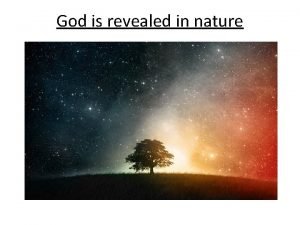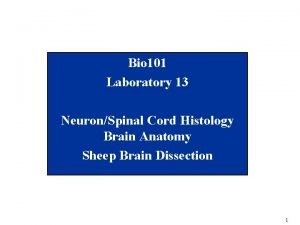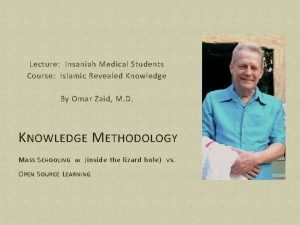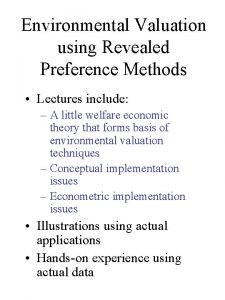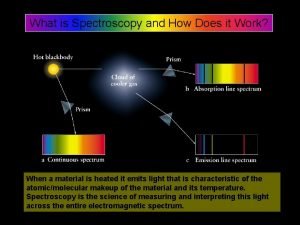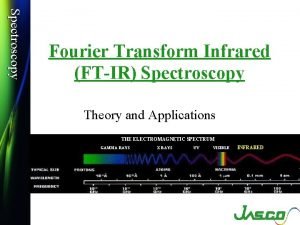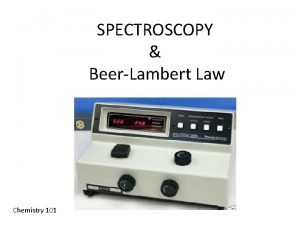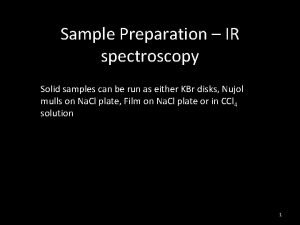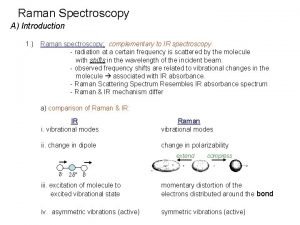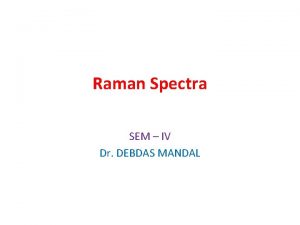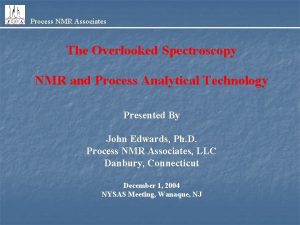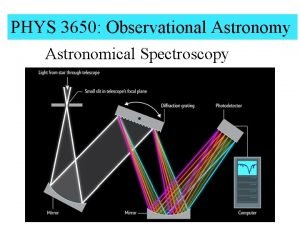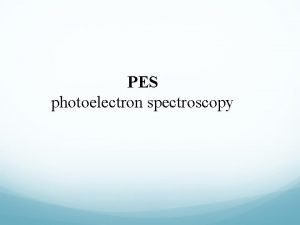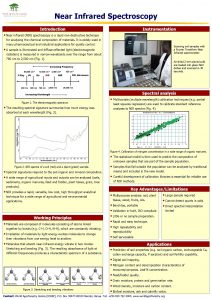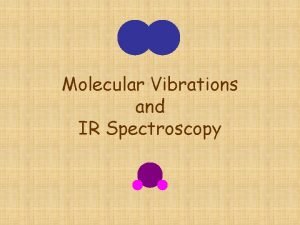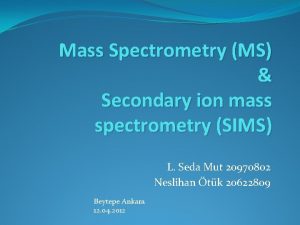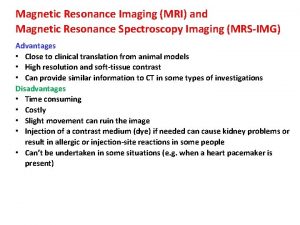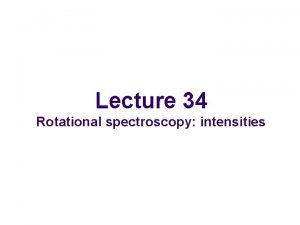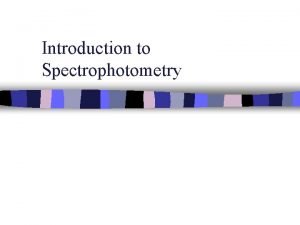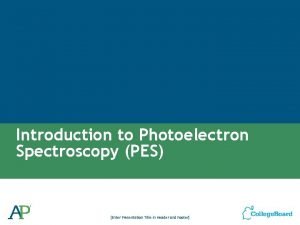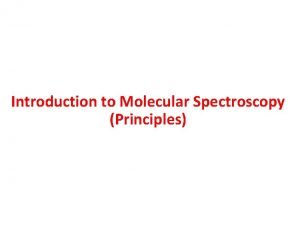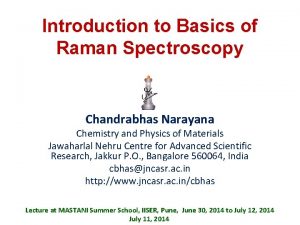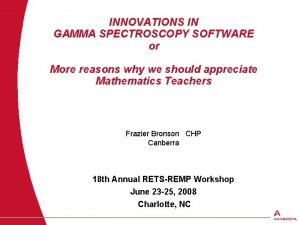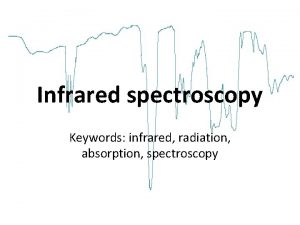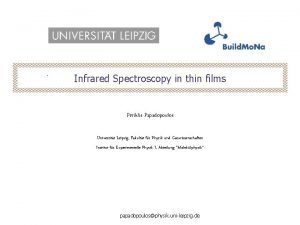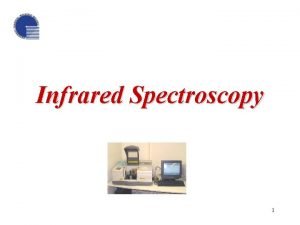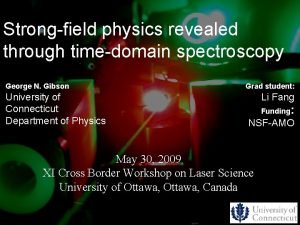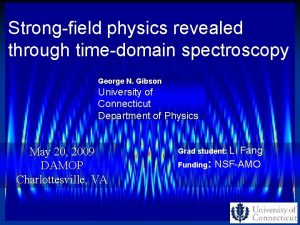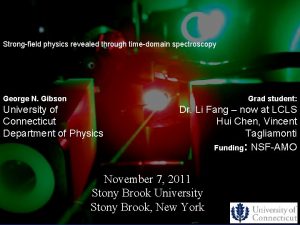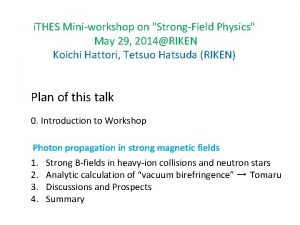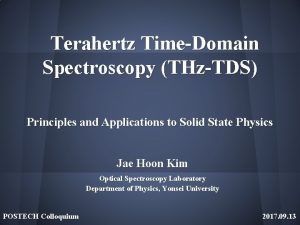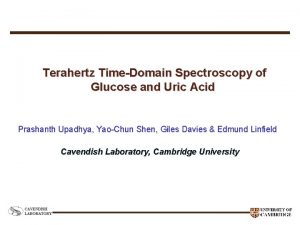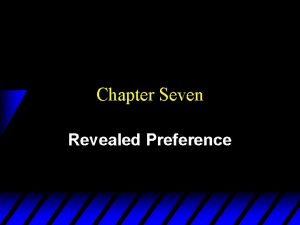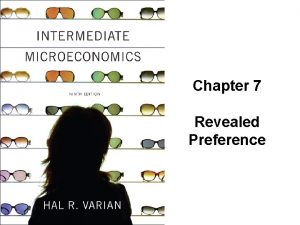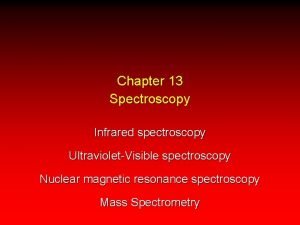Strongfield physics revealed through timedomain spectroscopy George N


















































- Slides: 50

Strong-field physics revealed through time-domain spectroscopy George N. Gibson Grad student: University of Connecticut Department of Physics Li Fang – now at LCLS November 18, 2009 Stevens Institute of Technology Hoboken, New Jersey Funding: NSF-AMO

Motivation Vibrational motion in pump-probe experiments reveals the role of electronically excited intermediate states. n This raises questions about how the intermediate states are populated. Also, we can study how they couple to the final states that we detect. n We observe inner-orbital ionization, which has important consequences for HHG and quantum tomography of molecular orbitals. n

Pump-probe experiment with fixed wavelengths. In these experiments we used a standard Ti: Sapphire laser: 800 nm 23 fs pulse duration 1 k. Hz rep. rate Probe Pump

Pump-probe spectroscopy on Enhanced Excitation Enhanced Ionization at Rc Internuclear separation of dissociating molecule 2+ I 2

Lots of vibrational structure in pump-probe experiments

Vibrational structure Depends on: n wavelength (400 to 800 nm). n relative intensity of pump and probe. n polarization of pump and probe. n dissociation channel. n We learn something different from each signal. n Will try to cover several examples of vibrational excitation.

I 2+ pump-probe data

(2, 0) vibrational signal Amplitude of vibrations so large that we can measure changes in KER, besides the signal strength. n Know final state – want to identify intermediate state. n

I 2 potential energy curves

Simulation of A state

Simulation results From simulations: - Vibrational period - Wavepacket structure - (2, 0) state

What about the dynamics? How is the A-state populated? n I 2+ (I 2+)* - resonant excitation? n I 2 (I 2+)* directly – innershell ionization? n No resonant transition from X to A state in I 2+. n

From polarization studies The A state is only produced with the field perpendicular to the molecular axis. This is opposite to most other examples of strong field ionization in molecules. n The A state only ionizes to the (2, 0) state!? Usually, there is a branching ratio between the (1, 1) and (2, 0) states, but what is the orbital structure of (2, 0)? n Ionization of A to (2, 0) stronger with parallel polarization. n

Implications for HHG and QT We can readily see ionization from orbitals besides the HOMO. n Admixture of HOMO-1 depends on angle. n n Could be a major problem for quantum tomography, although this could explain some anomalous results.

(2, 0) potential curve retrieval It appears that I 22+ has a truly bound potential well, as opposed to the quasi-bound ground state curves. This is an excimer-like system – bound in the excited state, dissociating in the ground state. Perhaps, we can form a UV laser out of this.

Wavelength-dependent pump probe scheme Change inner and outer turning points of the wave packet by tuning the coupling wavelength. Femtosecond laser pulses: Pump pulse: variable wavelength. (517 nm, 560 nm and 600 nm. ) Probe pulse: 800 nm.

Vibrational period (fs) I 2+ spectrum: vibrations in signal strength and kinetic energy release (KER) for different pump pulse wavelength [517 nm, 560 nm and 600 nm] X-B coupling wavelength (nm)

Simulation: trapped population in the (2, 0) potential well pump-probe delay=180 fs The (2, 0) potential curve measured from the A state of I 2+ in our previous work: PRA 73, 023418 (2006)

I 2+ + In+ dissociation channels

Neutral ground state vibrations in I 2 Oscillations in the data appear to come from the X state of neutral I 2. n Measured the vibrational frequency and the revival time. n

Revival structure n Vibrational frequency Measured 211. 0 0. 7 cm-1 Known 215. 1 cm-1 Finite temp 210. 3 cm-1

Raman scattering/Bond softening n Raman transitions are made possible through coupling to an excited electronic state. This coupling also gives rise to bond softening, which is well known to occur in H 2+.

Lochfrass n New mechanism for vibrational excitation: “Lochfrass” R-dependent ionization distorts the ground state wavefunction creating vibrational motion. n Seen by Ergler et al. PRL 97, 103004 (2006) in D 2+.

Lochfrass vs. Bond softening n Can distinguish these two effects through the phase of the signal. LF = n BS = /2. n

Iodine vs. Deuterium Iodine better resolved: 23 fs pulse/155 fs period = 0. 15 (iodine) 7 fs pulse/11 fs period = 0. 64 (deuterium) n Iodine signal huge: n DS/Save = 0. 10 n DS/Save = 0. 60 n

Variations in kinetic energy n Amplitude of the motions is so large we can see variations in KER or <R>.

Temperature effects Deuterium vibrationally cold at room temperature Iodine vibrationally hot at room temperature n Coherent control is supposed to get worse at high temperatures!!! But, we see a huge effect. Intensity dependence also unusual n We fit <R> = DRcos(wt+ ) +Rave As intensity increases, DR increases, Rave decreases. n

Intensity dependence n Also, for Lochfrass signal strength should decrease with increasing intensity, as is seen.

n But, Rave temperature: T decreases while DR

We have an incoherent sea of thermally populated vibrational states in which we ionize a coherent hole: n So, we need a density matrix approach.

Density matrix for a 2 -level model n For a thermal system where p 1(T) and p 2(T) are the Boltzmann factors. This cannot be written as a superposition of state vectors.

Time evolution of r n We can write: n These we can evolve in time.

Coherent interaction – use p/2 pulse for maximum coherence n Off diagonal terms have opposite phases. This means that as the temperature increases, p 1 and p 2 will tend to cancel out and the coherence will decrease.

R-dependent ionization – assume only the right well ionizes. n yf = (yg + ye)/2 n Trace(r) = ½ due to ionization What about excited state? NO TEMPERATURE DEPENDENCE!

Expectation value of R, <R> The expectation values are /2 out of phase for the two interactions as expected.

Comparison of two interactions Coherent interactions: n Off diagonal terms are imaginary. n Off diagonal terms of upper and lower states have opposite signs and tend to cancel out. R-dependent ionization n Off-diagonal terms are real. n No sign change, so population in the upper state not a problem. Motion produced by coherent interactions and Lochfrass are /2 out of phase.

“Real” (many level) molecular system Include electronic coupling to excited state. n Use I(R) based on ADK rates. Probably not a good approximation but it gives R dependence. n Include n = 0 - 14 n

Generalize equations

Same conclusions For bond-softening n Off-diagonal terms are imaginary and opposite in sign to next higher state. r 12(1) -r 12(2) n DR decreases and <n> increases with temperature. For Lochfrass n Off diagonal terms are real and have the same sign. r 12(1) r 12(2) n DR increases and <n> decreases with temperature.

n Excitation from Lochfrass will always yield real off diagonal elements with the same sign for excitation and deexcitation [f(R) is the survival probablility]:

DR and <n>

Density matrix elements

Conclusions Coherent reversible interactions n Off-diagonal elements are imaginary n Excitation from one state to another is out-of-phase with the reverse process leading to a loss of coherence at high temperature n Cooling not possible Irreversible dissipative interactions n Off-diagonal elements are real n Excitation and de-excitation are in phase leading to enhanced coherence at high temperature n Cooling is possible

Conclusions n Excitation of the A-state of I 2+ through inner-orbital ionization n Excitation of the B-state of I 2 to populate the bound region of (2, 0) state of I 22+ n Vibrational excitation through tunneling ionization.

Laser System • Ti: Sapphire 800 nm Oscillator • Multipass Amplifier • 750 J pulses @ 1 KHz • Transform Limited, 25 fs pulses • Can double to 400 nm • Have a pump-probe setup

Ion Time-of-Flight Spectrometer

Phase lag

Ionization geometry

Ionization geometry

I 2+ pump-probe data
 King george vs george washington
King george vs george washington George washington vs king george iii venn diagram
George washington vs king george iii venn diagram Correction of errors
Correction of errors Mood of the passage
Mood of the passage Revealed knowledge adalah
Revealed knowledge adalah Universal themes
Universal themes When is the universal theme of a story often revealed?
When is the universal theme of a story often revealed? Revealed truth definition
Revealed truth definition The wrath of god is revealed
The wrath of god is revealed Surah revealed in makkah
Surah revealed in makkah What is revealed is condemned
What is revealed is condemned God is revealed in nature
God is revealed in nature The wrath of god is revealed
The wrath of god is revealed Correction of errors in accounting questions
Correction of errors in accounting questions Inferior view of sheep brain labeled
Inferior view of sheep brain labeled Revealed preference theory
Revealed preference theory Revealed knowledge in education
Revealed knowledge in education Revealed preference methods of environmental valuation
Revealed preference methods of environmental valuation Sin entered through one man
Sin entered through one man Classes of furcation
Classes of furcation Conversion of timber
Conversion of timber Night of the scorpion ppt
Night of the scorpion ppt Why does it happen
Why does it happen University physics with modern physics fifteenth edition
University physics with modern physics fifteenth edition Physics ia topic
Physics ia topic What is spectroscopy
What is spectroscopy Allowed electronic transition
Allowed electronic transition Terahertz spectroscopy principles and applications
Terahertz spectroscopy principles and applications Ir spectroscopy definition
Ir spectroscopy definition Beer lambert law in uv spectroscopy
Beer lambert law in uv spectroscopy Ir sample preparation
Ir sample preparation Prinsip dasar aas
Prinsip dasar aas What is the difference between ftir and raman spectroscopy
What is the difference between ftir and raman spectroscopy Difference between ir and raman spectroscopy
Difference between ir and raman spectroscopy Advantages and disadvantages of spectroscopy
Advantages and disadvantages of spectroscopy Objectives of spectroscopy
Objectives of spectroscopy How does pes work
How does pes work Nir spectroscopy instrumentation
Nir spectroscopy instrumentation Stretching and bending vibrations in ir spectroscopy
Stretching and bending vibrations in ir spectroscopy Mass spec principle
Mass spec principle Advantages of nmr spectroscopy
Advantages of nmr spectroscopy Gross selection rule for rotational spectroscopy
Gross selection rule for rotational spectroscopy Introduction to spectrophotometry
Introduction to spectrophotometry Draw a photoelectron spectrum for aluminum
Draw a photoelectron spectrum for aluminum Dept nmr spectroscopy
Dept nmr spectroscopy Applications of uv spectroscopy
Applications of uv spectroscopy Raman spectroscopy basics
Raman spectroscopy basics Ortec renaissance
Ortec renaissance Infrared spectroscopy
Infrared spectroscopy Spectroscopy equations
Spectroscopy equations Application of ir spectroscopy
Application of ir spectroscopy











